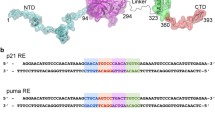Abstract
We have computed the low energy conformations of the negative regulatory domain of p53, residues 374–388 using Empirical Conformational Energies of Peptides Program including solvation and computed the statistical weights of distinct conformational states. We find that there are two high probability conformations, one an α-helix from Lys 374–Lys 381, followed by another helical structure involving Lys 382–Glu 388 (statistical weight of 0.48) and an all-α-helix for the entire sequence (statistical weight of 0.23). Both structure are superimposable on the NMR structure of this sequence bound to the S100 protein. The global minimum structure (statistical weight of 0.014) is a beta structure from Gly 374–Arg 379 followed by an α-helix from His 380–Glu 388. Based on these results, we propose a possible strategy for enhancement of p53 anti-tumor activity in cancer cells. Since the structure of this sequence bound to the sirtuin protein, Sir2, is a β-sheet, we further propose that the global minimum may be an intermediate on the α-β structure transition.


Similar content being viewed by others
Abbreviations
- NRD:
-
Negative regulatory domain of p53
- RMS:
-
Root mean square deviation
- ECEPP:
-
Empirical Conformational Energies of Peptides Program
- NOE:
-
Nuclear overhauser effect
References
Fernandez-Fernandez MR, Sot B (2011) The relevance of protein–protein interactions for p53 function. Protein Eng Des Sel 24:41–51
Stavridi ES, Huyen Y, Sheston EA, Hazelonetis TD (2005) In: Zambetti (ed) The p53 tumor suppressor and cancer. Springer, New York
Cho Y, Gorina S, Jeffrey PD, Pavletich NP (1994) Crystal structure of a p53 tumor suppressor-DNA complex: understanding tumorigenic mutations. Science 265:334–335
Jeffrey PD, Gorina S, Paveltich NP (1994) Crystal structure of the tetramerization domain of the p53 tumor suppressor at 1.7 angstroms. Science 267:1498–1502
Kussie PH, Gorina S, Marechal V et al (1996) Structure of the MDM2 oncoprotein bound to the p53 tumor suppressor transactivation domain. Science 174:948–953
Rosal R, Pincus MR, Brandt-Rauf PW, Fine RL, Michl J, Wang H (2004) NMR solution structure of a peptide from the mdm-2 binding domain of the p53 protein that is selectively cytotoxic to cancer cells. Biochemistry 43:1854–1861
Rustandi RR, Baldisseri DM, Weber DJ (2000) Structure of the negative regulatory domain of p53 bound to S100B (ββ). Nat Struct Biol 7:570–574
Avalos JL, Celic I, Muhammad S, Cosgrove MS, Boeke JD, Wolberger C (2002) Structure of a Sir 2 enzyme bound to an acetylated p53 peptide. Mol Cell 10:523–536
Uversky V, Oldfield CJ, Dunker AK (2008) Intrinsically disordered proteins in human diseases. Introducing the D2 concept. Ann Rev Biophys 37:215–246
Pincus M (1988) The chain build-up procedure in computing the structures of biologically active polypeptides and proteins. Int J Quantum Chem Quantum Biol Symp 15:209–220
Scheraga HA, Liwo A, Oldziej S, Czaplewski A, Pillardy J, Ripoll DR, Vila JA, Kazmierkiewicz R, Saunders JA, Arnautova YA, Jagielska A, Chinchio M, Nanias M (2004) The protein folding problem: global optimization of the force fields. Front Biosci 9:3296–3323
Hodes ZI, Nemethy G, Scheraga HA (1979) Model for the conformational analysis of hydrated peptides. Effect of hydration on the conformational stability of the terminally blocked residues of the 20 naturally occurring amino acids. Biopolymers 18:1565–1610
Pincus MR, Woo J, Monaco R, Lubowsky J, Avitable M, Carty RP (2014) The low-energy conformations of gonadotropin-releasing hormone in aqueous solution. Protein J 33:565–574
Pincus MR, Woo J, Monaco R, Lubowski J, Carty RP (2014) Low energy conformations for gonadotropin-releasing hormone with d- and l-amino acid substitutions for Gly 6: possible receptor-bound conformations. Protein J 33:575–587
Pincus MR, Carty RP, Harding M, Epstein W (2012) Calculation of the three-dimensional structures of two antigenic sequences, Pro-Pro-Pro-Pro-Asn-Pro-Asn-Asp-Pro and Pro-Pro-Pro-Pro-Asn-Pro-Asn-Asp-Pro-Pro-Pro, of the circumsporozoite protein from a malaria-causing plasmodium. Protein J 32:58–67
Gibson K, Chin S, Pincus MR, Clementi E, Scheraga HA (1986) Parallelism in conformational energy calculations on proteins: partial structure of interferon. In: Dupuis M (ed) Montreal symposium on supercomputer simulation in chemistry. Lecture notes in chemistry, vol 44. Springer, Berlin, pp 198–213
Pincus MR, Brandt-Rauf PW, Gibson K, Carty RP, Lubowsky J, Avitable M, Scheraga HA (1987) Conformational effects of substituting amino acids for Gln 61 on the central transforming region of the P21 proteins. Proc Natl Acad Sci USA, 89:8375–8379
Zimmerman SS, Scheraga HA (1977) Influence of local interactions on protein structure. I. Conformational energy studies of N-acetyl-N’-methylamides of Pro-X and X-Pro dipeptides. Biopolymers 16:811–843
Chary KVR, Srivastava S, Hosur RV, Roy KB, Govil G (1986) Molecular conformation of gonadoliberin using two-dimensional NMR spectoscopy. Eur J Biochem 158:323–352
Pappa EV, Zompra AA, Diamantopoulou Z, Spyranti Z, Pairas G, Lamari FN, Katsoris P, Spyroulias GA, Cordopatis P (2012) Structure-activity studies of IGnRHIII through rational amino acid substitution and NMR conformational studies. Biopolymers 98:525–534
Bheda P, Jing H, Wolberger C, Lin H (2016) The substrate specificity of sirtuins. Annu Rev Biochem 85:405–429
Author information
Authors and Affiliations
Corresponding author
Rights and permissions
About this article
Cite this article
Carty, R.P., Lin, B., Fridman, D. et al. Low Energy Conformations for S100 Binding Peptide from the Negative Regulatory Domain of p53. Protein J 37, 510–517 (2018). https://doi.org/10.1007/s10930-018-9799-1
Published:
Issue Date:
DOI: https://doi.org/10.1007/s10930-018-9799-1




